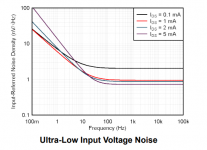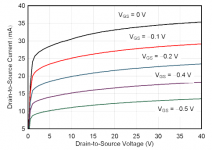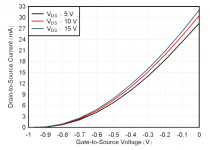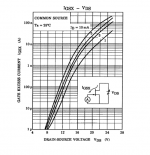We recently launched the JFE150, a discrete N-channel JFET targeting low noise applications: JFE150 data sheet, product information and support | TI.com
Some key specs of the JFE150:
1. 0.8 nV/rtHz broadband noise at an IDS of 5mA
2. 10pA of gate current (max), for lower drain-to-source voltages. Gate current takes off above about 5V VDS. This gives 1.8 fA/rtHz input current noise
3. 40V gate to source breakdown voltage
4. 24pF input capacitance (VDS = 5V)
5. Typical IDSS is 35mA, guaranteed limits are 24mA to 46mA
6. Integrated clamping diodes. These can be floated if not used.
7. Price is about $2 in low quantities, available on the TI Store now.
This device is the first in a new series of low noise JFETs from TI. I'm personally very excited about these devices because I believe the market could use more options for high performance JFETs. I'll post here again when we release more devices in this family. I'm looking forward to seeing the feedback here on these new parts!
Some selected datasheet plots are attached.
I'm updating this post to highlight that the N-ch matched pair is now live on ti.com: https://www.ti.com/product/JFE2140
Some key specs of the JFE150:
1. 0.8 nV/rtHz broadband noise at an IDS of 5mA
2. 10pA of gate current (max), for lower drain-to-source voltages. Gate current takes off above about 5V VDS. This gives 1.8 fA/rtHz input current noise
3. 40V gate to source breakdown voltage
4. 24pF input capacitance (VDS = 5V)
5. Typical IDSS is 35mA, guaranteed limits are 24mA to 46mA
6. Integrated clamping diodes. These can be floated if not used.
7. Price is about $2 in low quantities, available on the TI Store now.
This device is the first in a new series of low noise JFETs from TI. I'm personally very excited about these devices because I believe the market could use more options for high performance JFETs. I'll post here again when we release more devices in this family. I'm looking forward to seeing the feedback here on these new parts!
Some selected datasheet plots are attached.
I'm updating this post to highlight that the N-ch matched pair is now live on ti.com: https://www.ti.com/product/JFE2140
Attachments
Last edited:
A p-channel counterpart is definitely something we're considering. It wasn't a major demand from our lead customers so it got put on the back burner. But if there's enough demand here I think we'd take another look...
Mike, the owner of this development, will be chiming in on this thread as well. So be sure to yell at him that you want a P-channel.
Mike, the owner of this development, will be chiming in on this thread as well. So be sure to yell at him that you want a P-channel.
A few questions :
1) There does not seem to be any data or information on the leakage of the integrated diodes.
2) There seems to be no grading of devices according to Idss, as in many other audio JFETs.
3) Can you remark on the dependence of Id vs Vds as compared to e.g. 2SK170 ?
4) What is the maximum dissipation without affecting reliability, assuming normal traces and no special heat dissipation copper on the PCB ?
5) At almost 1µA of gate leakage at 15V Vds, can it be realistically used without cascoding ?
Thanks in advance,
Patrick
1) There does not seem to be any data or information on the leakage of the integrated diodes.
2) There seems to be no grading of devices according to Idss, as in many other audio JFETs.
3) Can you remark on the dependence of Id vs Vds as compared to e.g. 2SK170 ?
4) What is the maximum dissipation without affecting reliability, assuming normal traces and no special heat dissipation copper on the PCB ?
5) At almost 1µA of gate leakage at 15V Vds, can it be realistically used without cascoding ?
Thanks in advance,
Patrick
Hi Patrick:
1) We test the gate current leakage in the INPUT CURRENT spec. with the clamp voltages set to 5 V and -5 V. Overall, the clamp diodes contribute very little current to the leakage (the diode size, and therefore leakage, is much smaller than the JFET).
2) Correct, there is no grading, all JFE150's will use the specs. listed in the EC table.
3) I'll have to check on output impedance/Id vs Vds compared to 2SK170.
4) Theta JA is ~ 200 C/W, and die temp. should stay at or below 125C. So, max. power can be calculated by P = (125 - max. ambient temp)/200.
5) Depends on input/source impedance - for the highest input/source impedance cases, we would generally expect < 5 V VDS without cascoding (I believe you know, but, just in case, higher gate leakage with increasing VDS occurs on all JFETs).
Best Regards,
Mike
1) We test the gate current leakage in the INPUT CURRENT spec. with the clamp voltages set to 5 V and -5 V. Overall, the clamp diodes contribute very little current to the leakage (the diode size, and therefore leakage, is much smaller than the JFET).
2) Correct, there is no grading, all JFE150's will use the specs. listed in the EC table.
3) I'll have to check on output impedance/Id vs Vds compared to 2SK170.
4) Theta JA is ~ 200 C/W, and die temp. should stay at or below 125C. So, max. power can be calculated by P = (125 - max. ambient temp)/200.
5) Depends on input/source impedance - for the highest input/source impedance cases, we would generally expect < 5 V VDS without cascoding (I believe you know, but, just in case, higher gate leakage with increasing VDS occurs on all JFETs).
Best Regards,
Mike
Patrick,
The typical curves do show higher gate currents at 10 V. However we specify 10 pA (max, tested) for JFE150 at VDS = 2 V. I don't know how much total variation there may be in gate current for a population of competitive devices- if they start higher at VDS = 2 V, the trend will continue as VDS is increased.
I looked into your projects at XEN audio, looks very interesting- I'd love to hear your feedback about JFE150!
Best Regards,
Mike
The typical curves do show higher gate currents at 10 V. However we specify 10 pA (max, tested) for JFE150 at VDS = 2 V. I don't know how much total variation there may be in gate current for a population of competitive devices- if they start higher at VDS = 2 V, the trend will continue as VDS is increased.
I looked into your projects at XEN audio, looks very interesting- I'd love to hear your feedback about JFE150!
Best Regards,
Mike
> I'd love to hear your feedback about JFE150!
Most likely the JFE150 is not a part that is specifically designed for audio applications.
And if one would accept those limitations, one can get close to most of its specs by putting e.g. 2x 2SK2394-6 in parallel.
The 2SK170 is a good example of NJFET for audio applications.
It can take quite a bit more Vds & dissipation, and is available in different Idss grades which are useful for audio.
(20mA is certainly too high for most applications)
There are variants such as 2SK369, which is almost equal to 2x 2SK170 in //.
Or one can use 2x 2SK209GR // to get very close to a single 2SK170BL.
So I am still spoilt for choices before I am tempted to dish out 2 USD for the JFE150.
If you ask people here what they would like for JFETs, that most will say 2SK170/2SJ74.
It has taken Linear Systems many many years before they got somewhat close to the Toshiba's.
But I am sure TI has considerably more resources and know how.
Whether the market for analogue audio is still big enough to make business sense is another matter.
Cheers,
Patrick
Most likely the JFE150 is not a part that is specifically designed for audio applications.
And if one would accept those limitations, one can get close to most of its specs by putting e.g. 2x 2SK2394-6 in parallel.
The 2SK170 is a good example of NJFET for audio applications.
It can take quite a bit more Vds & dissipation, and is available in different Idss grades which are useful for audio.
(20mA is certainly too high for most applications)
There are variants such as 2SK369, which is almost equal to 2x 2SK170 in //.
Or one can use 2x 2SK209GR // to get very close to a single 2SK170BL.
So I am still spoilt for choices before I am tempted to dish out 2 USD for the JFE150.
If you ask people here what they would like for JFETs, that most will say 2SK170/2SJ74.
It has taken Linear Systems many many years before they got somewhat close to the Toshiba's.
But I am sure TI has considerably more resources and know how.
Whether the market for analogue audio is still big enough to make business sense is another matter.
Cheers,
Patrick
Thanks for the feedback Patrick,
True, the small SC-70 isn't the best for thermal dissipation, we were targeting applications that require small PCB footprints.
As for the use in Audio, the main attraction is the ability to achieve ultra-low noise, better than any other JFET we have measured at the same IDS. We have more data/collateral on the way that will highlight the advantages of this JFET (specifically noise) and why we believe it will be popular for audio amps.
More to come,
Mike
True, the small SC-70 isn't the best for thermal dissipation, we were targeting applications that require small PCB footprints.
As for the use in Audio, the main attraction is the ability to achieve ultra-low noise, better than any other JFET we have measured at the same IDS. We have more data/collateral on the way that will highlight the advantages of this JFET (specifically noise) and why we believe it will be popular for audio amps.
More to come,
Mike
Hi John and Mike,
Nice part, even better is you divided it in two, for a matched dual with half the input capacitance and transconductance....
And then the complementary P-ch
Thanks Soekris!
That is a very good idea - we have a dual, matched N-ch device on the way, I'll be back in touch in a few weeks regarding that one!
Best Regards,
Mike
With the IF3601/3602's price and input capacitance you could
easily afford an array of 1 or 2 dozen parallel JFE150.
< https://www.mouser.de/ProductDetail...2pyFadugZsfEicURv%2BOjXzAE808oqw/%2BZ2Iaip5M= >
The revised data sheet takes away some glory.
Does the JFE150 have an upper frequency? That's carefully avoided in the DS.
BTW
Is there still a data sheet for the TI P8000 and P8002?
More for museum reasons, but I still have a few of the P8002.
Used to be the deLuxe 50 Ohm termination in CG for RF mixers.
Methinks a JFET in TO-220 would have a fan club here.
 Gerhard
Gerhard
easily afford an array of 1 or 2 dozen parallel JFE150.
< https://www.mouser.de/ProductDetail...2pyFadugZsfEicURv%2BOjXzAE808oqw/%2BZ2Iaip5M= >
The revised data sheet takes away some glory.
Does the JFE150 have an upper frequency? That's carefully avoided in the DS.
BTW
Is there still a data sheet for the TI P8000 and P8002?
More for museum reasons, but I still have a few of the P8002.
Used to be the deLuxe 50 Ohm termination in CG for RF mixers.
Methinks a JFET in TO-220 would have a fan club here.
Last edited:
No more.
But i confess I have bought > a dozen of them to get some similar pairs.
Costly error. Learning is not cheap.
< DSC_0661 | Gerhard Hoffmann | Flickr >
< DSC_0455 | Low noise JFET amplifier. Either 16*BF862 or two … | Flickr >
< 8pcs_IF3602 | 8 pairs of Interfet IF3602 JFETs Id vs Vgs | Gerhard Hoffmann | Flickr >
But they offer a selection service. I guess what us mortals get at Mouser is the remainder.
But i confess I have bought > a dozen of them to get some similar pairs.
Costly error. Learning is not cheap.
< DSC_0661 | Gerhard Hoffmann | Flickr >
< DSC_0455 | Low noise JFET amplifier. Either 16*BF862 or two … | Flickr >
< 8pcs_IF3602 | 8 pairs of Interfet IF3602 JFETs Id vs Vgs | Gerhard Hoffmann | Flickr >
But they offer a selection service. I guess what us mortals get at Mouser is the remainder.
Last edited:
Thank you JohnC and MikeH!!
I'm trying to buy some of these from the TI Store and having web difficulties. Probably user error! Will have another go tomorrow.
Let us know if you're still having issues. Sometimes things around product launch can be a little buggy.
> Better than IF3602 ?
No we did not compare to IF3602, only to similar size JFETs. To add to Gerhart's point, though, we created a design with 3 in parallel, and were able to achieve 0.545 pV/rthz (@1kHz), biased with 2.2 mA per JFE150, in a bias scheme that can use JFE150 without any additional matching or screening. Acknowledged that was only in simulation, but our simulations matched very closely with our measurements on other designs.
Regards,
Mike
No we did not compare to IF3602, only to similar size JFETs. To add to Gerhart's point, though, we created a design with 3 in parallel, and were able to achieve 0.545 pV/rthz (@1kHz), biased with 2.2 mA per JFE150, in a bias scheme that can use JFE150 without any additional matching or screening. Acknowledged that was only in simulation, but our simulations matched very closely with our measurements on other designs.
Regards,
Mike
- Home
- Vendor's Bazaar
- Ultra Low Noise JFETs from Texas Instruments



